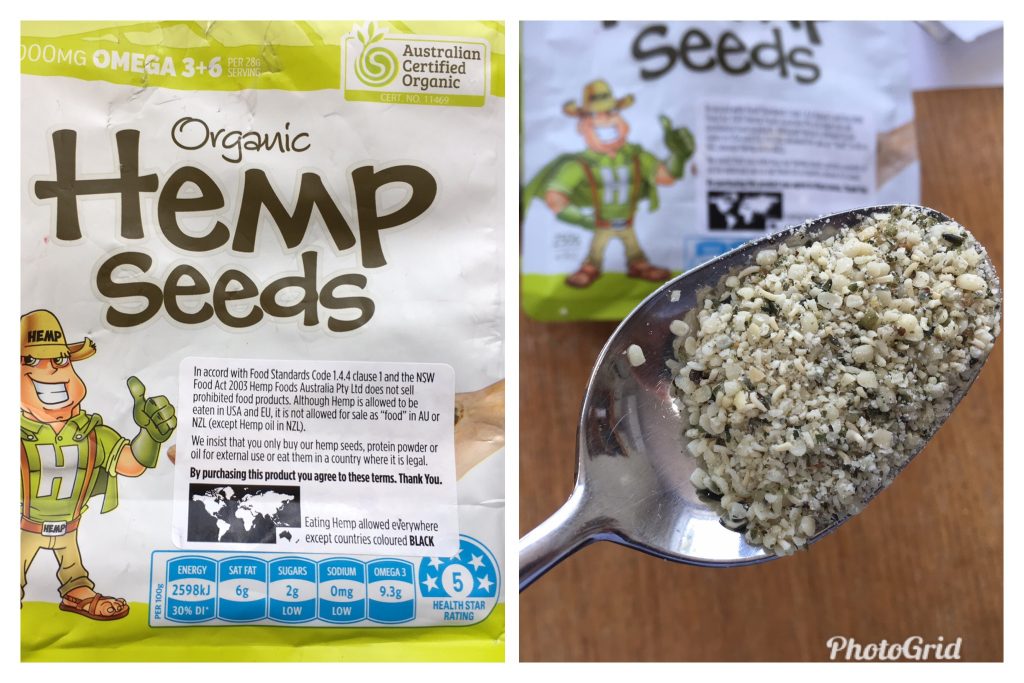
Australia lagged the rest of the world in approving the sale of hemp seeds for human consumption in late 2017. Prior to this, the sale of hemp seeds was legal, provided it was for use in cosmetics or another non-food use. Hemp seeds are produced from non-intoxicating varieties of the hemp plant and do not contain significant cannabinoids.
Hemp seeds will become widely available from 2018 and there will be many new products coming onto the market and many nutrition claims, possibly ‘superfood’ status. As with any other edible seeds, we recommend that if you are going to eat hemp seeds, that you eat whole or ground seeds and not processed food products such as hemp seed protein and hemp seed oil.
We have reviewed the nutrition composition of hemp seeds and compared them to several other nuts and seeds, particularly regarding their omega 3 essential fatty acid content. The USDA data that we used was similar to the nutrient data listed on two different brands of hemp seed in retail outlets.
Protein and other nutrients:
- Hemp seeds are much higher in protein (22% of calories) than flax or chia but lower than legumes.
- Flax and chia are far higher in dietary fibre than hemp and the fibre in flax (lignins) assists the body to excrete excess estrogens.
- The calcium content of the seeds ranged from very high for chia, moderate for flax and low for hemp.
Omega 3’s (alpha linolenic acid):
Many people have sub-optimal intakes of omega 3’s and perhaps more importantly, unfavourably high ratios of dietary omega 6 to omega 3. This is the result of low intakes of omega 3 rich plants combined with high intakes of omega 6 rich plants such as nuts, seeds, avocados as well as vegetable oils. An optimal omega 6 to 3 ratio is 4:1 or less.
For a whole food omega 3 source to bring the dietary omega 6 to 3 ratio into balance, it needs to have a ratio well below the target of 4:1. Flax (ratio 1:4) and chia (ratio 1:3) have more omega 3’s than 6’s and are therefore excellent sources of omega 3 fats. Hemp seeds (3:1) and walnuts (4:1) might be considered good sources on their own, but not good enough to compensate for the omega 6 rich foods in the typical plant-based diet. For more on omega 3’s see our Omega-3 Essential Fatty Acids page.
The following table gives comparative data for four high omega 3 nuts and seeds:
| Per 100 g | Flax | Chia | Hemp | Walnut |
|---|---|---|---|---|
| Calories | 534 | 490 | 553 | 765 |
| Fibre (g) | 27.3 | 37.7 | 4.0 | 7.8 |
| Protein (g) | 18.3 | 15.6 | 31.5 | 17.8 |
| Calcium (mg) | 255 | 631 | 70 | 115 |
| Carb: Fat: Protein (% Cal) | 22:66:12 | 36:53:11 | 6:72:22 | 9:83:8 |
| Omega 3 (g) | 22.8 | 17.5 | 9.3 | 8.7 |
| Omega 6 (g) | 5.9 | 5.7 | 30.9 | 27 |
| Omega 6 : 3 ratio | 1 : 3.9 | 1 : 3.1 | 3.1 : 1 | 4.1 : 1 |
The Australian recommended intake range of omega 3 fatty acids is 1-2 grams per day (see Nutrient Reference Values for Australia and New Zealand).
This is met by consuming 10g flax or chia per day.
Hemp seeds have a more favourable fatty acid profile than most other nuts and seeds but fall well behind flax seed and chia seed as a concentrated source of omega 3 fats. They have a mild taste and relatively soft texture which makes them suitable as an ingredient in a variety of dishes. Hemp seeds, like other nuts and seeds, can be a healthy addition to a whole foods, plant-based diet but are best consumed in small amounts.
See also:
Resources
- National Health and Medical Research Council. (2006). Nutrient Reference Values for Australia and New Zealand: Including Recommended Dietary Intakes. Canberra: NHMRC
- USDA Food Data Central
Page created 26 February 2018
Page last updated 2 March 2018
